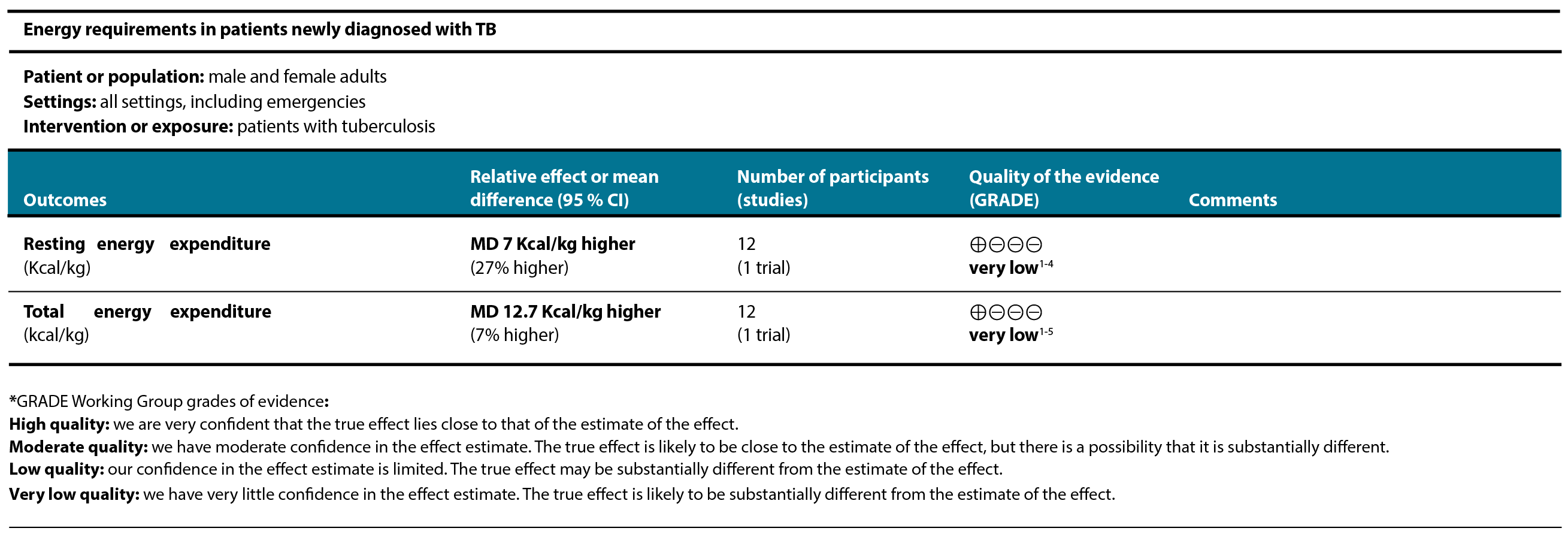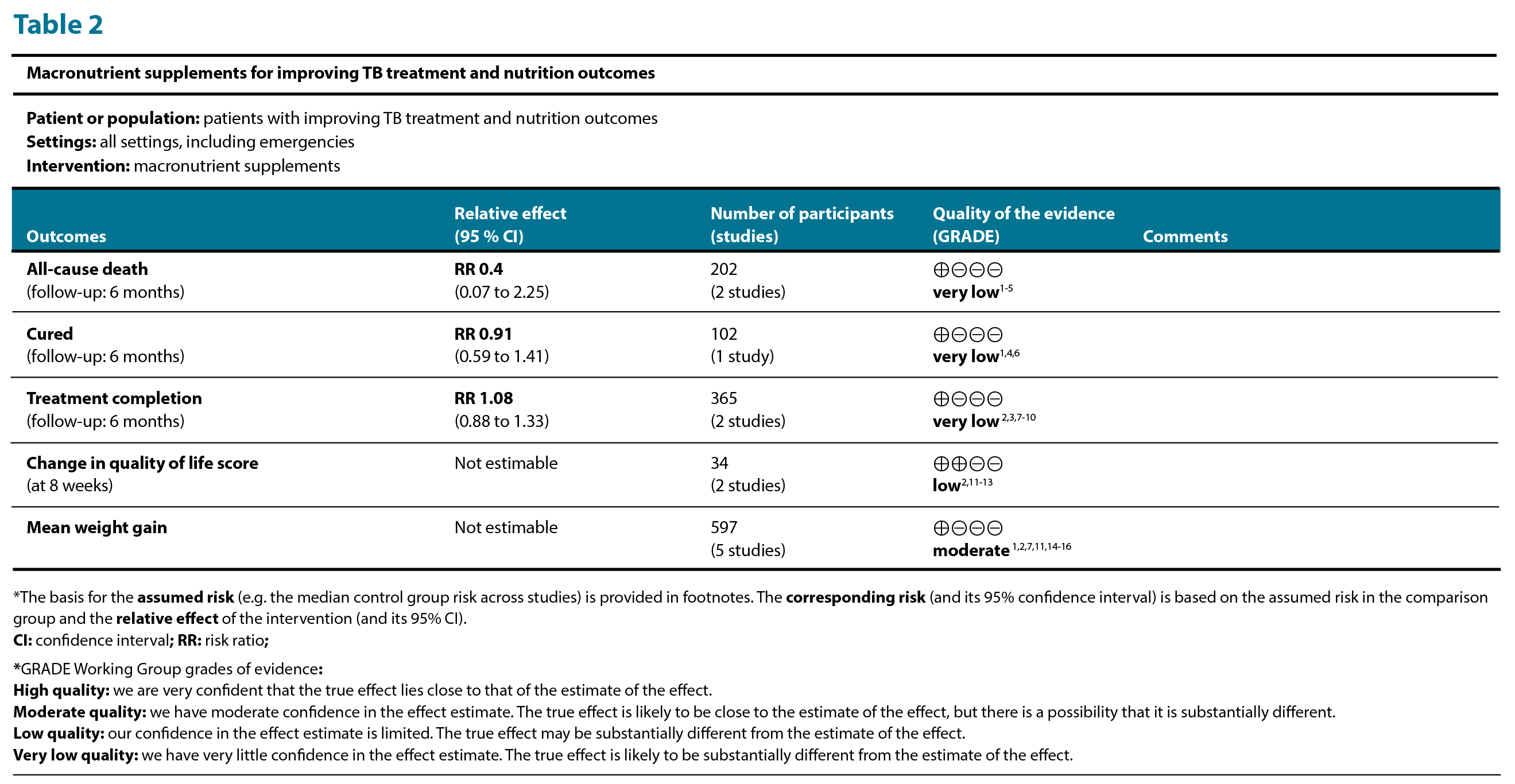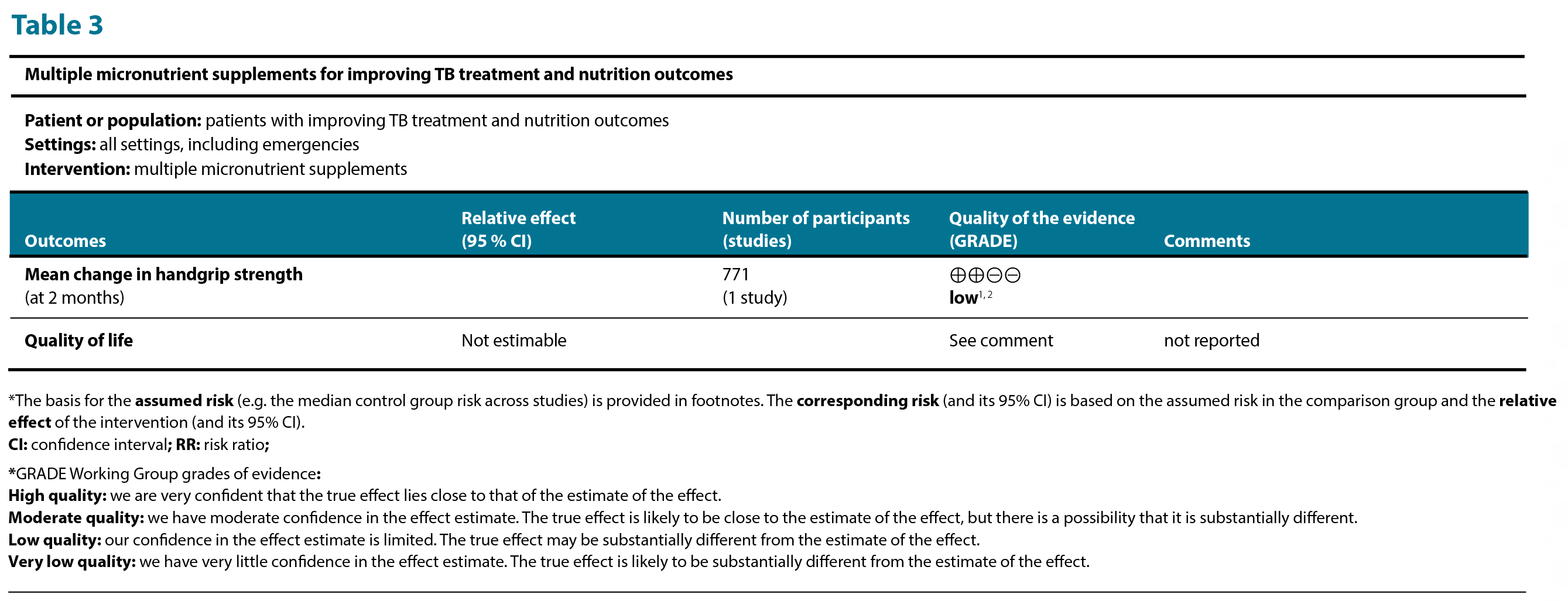كتاب روابط اجتياز لـ 1266



¹ Raj 2006 (India) compared six healthy volunteers with six newly diagnosed afebrile patients with pulmonary TB. The ¹³C-labelled bicarbonate method was used.
² Although the control group had significantly higher BMI at baseline than the patients with TB (21.1 vs 16.5, P<0.01), this is not a risk of bias but a necessary element of a study of this nature: comparing undernourished TB patients with normal weight healthy individuals
³ It is difficult to generalize to the whole TB population from a sample of six.
⁴ This study is seriously underpowered to confidently detect differences in energy expenditure. This result represents a 27% increase in resting energy expenditure per kg body weight. The statistical significance is not given.
⁵ This study is seriously underpowered to confidently detect differences in energy expenditure. This difference (a 7% increase in total energy expenditure per kg body weight) was described as ‘not significant’ by the authors. The P value was not given.
* For details of these studies see supplementary information (63).
¹ One study in India randomized 103 patients aged >12 years with TB to receive monthly ration packs or nutritional advice alone. The macronutrient supplement was a cereal and lentil mixture calculated to provide 930 kcal and 31.5 g protein per day. The mean BMI at baseline was 17.2 in the supplement group and 18.2 in the controls.
² One study in India randomized 100 adults with TB to receive a daily locally appropriate food supplement or nutritional advice alone. The supplement consisted of ‘sweet balls’ providing 6 g protein and 600 kcal per day. The mean BMI at baseline was 17.1 in the supplement group and 17.9 in the controls.
³ One study adequately concealed allocation and one did not. The studies were open.
⁴ Studies are only available from India. As nutritional status and food availability are likely to differ widely between settings, this result is not easily generalized to other settings.
⁵ These trials are severely underpowered to detect a clinically important effect if there is one. The optimal sample size is about 2000 participants. Martins 2009 did not report any deaths occurring after randomization.
⁶ This trial is severely underpowered to detect a clinically important effect if there is one. The optimal information size to detect an effect is over 700 participants.
⁷ One study in Timor-Leste randomized 270 adults with TB to receive a daily hot meal or nutritional advice alone. The daily meal during the intensive phase consisted of: a bowl of meat, kidney beans and vegetable stew with rice; and during the consolidation phase: a food parcel of unprepared red kidney beans, rice, and oil adequate for one meal, The population was significantly undernourished at baseline with 80% having a BM1 <18.5, and 30% <16.
⁸ One study found a statistically significant benefit in favour of supplementation while the other did not.
⁹ These two studies are from Timor-Leste, and India. As nutritional status is likely to differ between settings these results are not easily generalised to other settings or subpopulations.
¹⁰ The point estimate (1.08) indicates a small benefit with supplementation, however the 95% CI of the absolute effect includes the possibility of no effect with the intervention.
¹¹ One study compared high-energy nutritional supplements (≈ 900 kcal) plus nutritional advice versus nutritional advice alone in 36 adults in Singapore. The mean BMI at baseline was 16.7 in the supplement group and 17.9 in the control group.
¹² Only two very small trials, one from Singapore and one from India measured quality of life scores. The results cannot be generalized with any certainty.
¹³ The presented data appear highly skewed and could not be pooled.
¹⁴ One study in the United Republic of Tanzania randomized 865 adults with TB plus HIV coinfection to receive six high-energy protein biscuits or one. The mean BMI at baseline was 18.7 in the supplement group versus 18.5 in controls. The result, of a small benefit, is not statistically significant.
¹⁵ One study included only HIV-positive patients and although the trend was towards a benefit this did not reach statistical significance.
¹⁶ At 6 weeks the Singapore study found the mean weight to be 1.78 kg higher with supplements. At 8 weeks the study in Timor-Leste found the mean weight to be 1.7 kg higher with supplements, and at 12 weeks one of the studies in India found the mean weight to be 2.6 kg higher with supplements. All three results are statistically significant.
* For details of studies included in the review, see (27).
¹ One study in the United Republic of Tanzania enrolled 865 adults with TB. Researchers gave all participants a daily high-energy biscuit containing: 4.5 g protein, 615 kJ, 120 mg phosphorous, 120 mg calcium, 36 mg magnesium, 70 mg sodium, 150 mg potassium, and traces <1 mg of iron and zinc. The intervention group then received an additional: 1.5 mg vitamin A, 20 mg thiamine, 20 mg riboflavin, 25 mg vitamin B6, 50 µg vitamin B12, 800 µg (0.8 mg) folic acid, 40 mg niacin, 200 mg vitamin C, 60 mg vitamin E, 5 µg vitamin D, 0.2 mg selenium, 5 mg copper, 30 mg zinc.
² This was a single study from the United Republic of Tanzania. The findings are not easily generalized to other settings.
* For details of studies included in the review, see (27).

 تعليق
تعليق